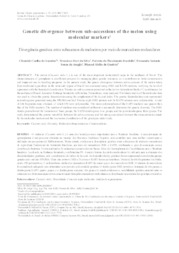Genetic divergence between sub-accessions of the melon using molecular markers.
Genetic divergence between sub-accessions of the melon using molecular markers.
Autoria: AMORIM, C. C. de; SILVA, F. D. da; BORDALLO, P. do N.; ARAGAO, F. A. S. de; QUEIRÓZ, M. A. de
Resumo: The melon (Cucumis melo L.) is one of the most important horticultural crops in the northeast of Brazil. The characterisation of germplasm is an ef ficient process for managing plant genetic resources, as it contributes to better conservation and improved use in breeding programs. In the present study, the genetic divergence between sub-accessions of the melon taken from traditional agriculture in the semi-arid region of Brazil was evaluated using ISSR and RAPD markers, verifying the level of agreement with the botanical classification. Twenty-six sub-accessions preserved in the Active Germplasm Bank of Cucurbitaceae for the northeast of Brazil, located at Embrapa Semiárido in Petrolina, Pernambuco, were analysed. The binary matrix of the molecular data was used to obtain the genetic dissimilarities using the complement of the Jaccard index. The genetic dissimilarities were represented in dendrograms generated using the UPGMA method. Twenty-eight ISSR primers and 26 RAPD primers were polymorphic. A total of 686 fragments were obtained, of which 451 were polymorphic. The mean polymorphism of the RAPD markers was greater than that of the ISSR markers. The number of markers was considered suf ficient to accurately determine the genetic diversity. The ISSR dendrogram allowed the formation of three groups, the RAPD dendrogram, four groups, and the joint dendrogram, three groups. The study demonstrated the genetic variability between the sub-accessions, and the strong association between the characterisation made by the molecular markers and the taxonomic classification of the genotypes under study.
Ano de publicação: 2022
Tipo de publicação: Artigo de periódico
Unidade: Embrapa Agroindústria Tropical
Observações
1 - Por padrão são exibidas publicações dos últimos 20 anos. Para encontrar publicações mais antigas, configure o filtro ano de publicação, colocando o ano a partir do qual você deseja encontrar publicações. O filtro está na coluna da esquerda na busca acima.
2 - Para ler algumas publicações da Embrapa (apenas as que estão em formato ePub), é necessário ter, no celular ou computador, um desses softwares gratuitos. Sistemas Android: Google Play Livros; IOS: iBooks; Windows e Linux: software Calibre.
Acesse outras publicações
Acesse a Base de Dados da Pesquisa Agropecuária (BDPA) para consultar o acervo completo das bibliotecas da Embrapa.

